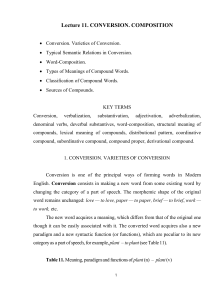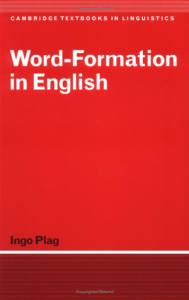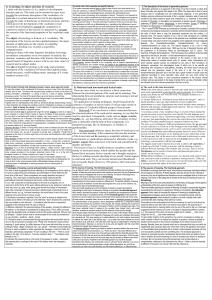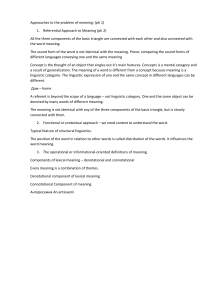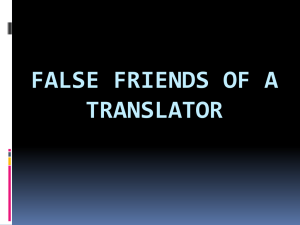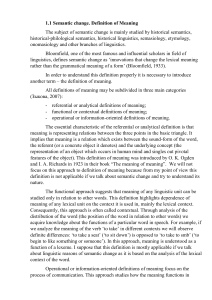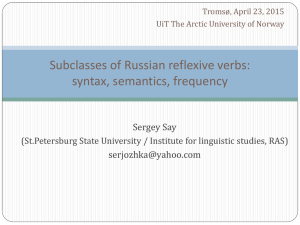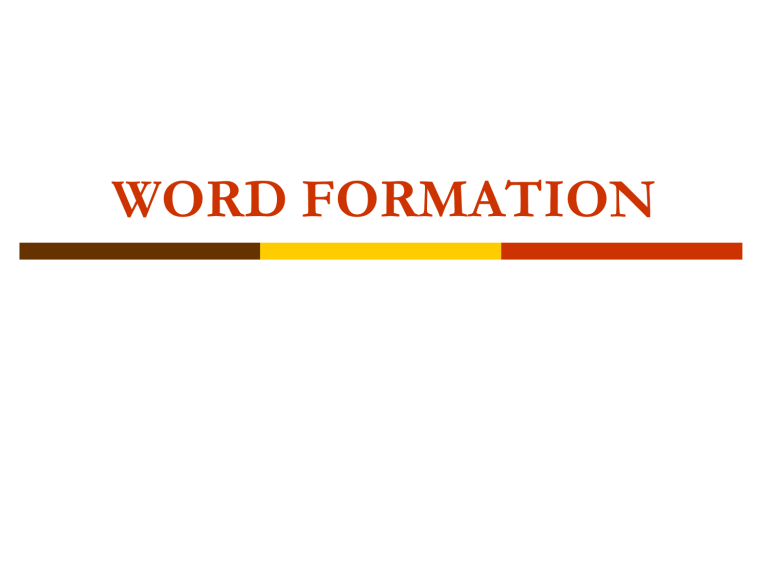
WORD FORMATION THE WORD-FORMING SYSTEM OF ENGLISH 1. 2. 3. Types of Forming Words. General Issues Major Types of Word-formation Minor Types of Word-formation Word-formation is a branch of Lexicology which studies the process of building new words, derivative structures and patterns of existing words. All ways of forming new words can be classified into two big groups: major and minor types of creating new words. Two major types – word-derivation and word-composition The minor types – comprise shortening, blending, acronymy, sound imitation, sound interchange, back-formation, distinctive stress. Major Types of Word-formation Word-formation deals with words which can be analyzed both structurally and semantically. Simple words are closely connected with word-formation: they serve as the foundation of derived and compound words. E.g., consumer, misunderstand, sugar free vs to consume, to understand, free are irrelevant to it. Major Types of Word-formation Major Types of Word-formation Word-derivation: affixation and conversion. Affixation is the formation of a new word with the help of affixes (happiness, misprint). Affixation → suffixation and prefixation. Suffixation is mostly to coin nouns and adjectives. Prefixation is mostly to coin verbs. Word-derivation deals with the derivational structure of words: derivational bases, derivational affixes and derivational patterns. Major Types of Word-formation A derivational base is the part of the word which establishes connection with the lexical unit that motivates the derivative and determines its individual lexical meaning describing the difference between words in one and the same derivative set. For example, the individual lexical meaning of the words consumer, dealer, teacher which denote active doers of the action is presented by the lexical meaning of the derivational bases: consume-, deal-, teach-. Major Types of Word-formation Derivational affixes are Immediate Constituents of derived words in all parts of speech. Derivational affixes are added to derivational bases. Affixes can be of two types: prefixes and suffixes. Major Types of Word-formation Prefixes modify the lexical meaning but rarely transfer a word into a different part of speech: hear (v) → overhear (v), fair (adj) → unfair (adj), president (n) → expresident (n), etc. Suffixes also modify the lexical meaning but not necessarily transfer a word into a different part of speech: king (n) → kingdom (n), book (n) → bookish (adj), rapid (adj) → rapidly (adv), etc. Major Types of Word-formation A derivational pattern is a regular meaningful arrangement, which imposes rigid rules on the order and the nature of the derivational base and affixes that may be brought together to create a new word. Derivational patterns are also known as structural formulas. Here are some examples of derivational patterns: n + -sf → N (friend + ship), v + -sf → N (sing + er), etc. Major Types of Word-formation Conversion is the formation of a new word by putting a stem of the already existing word into a different paradigm ( fly (noun) – fly (verb)), thus, by changing the category of a part of speech without adding any derivative elements, so that the original and the converted words become homonyms. E.g., the paradigm of the verb fly → fly, flies, flying, flew, flown, the paradigm of the noun fly → fly (sg) and flies (pl). Major Types of Word-formation Conversion is highly-productive and widely-spread among verbs and nouns. Converted words can sound extremely colloquial, e.g. I’ll microwave the chicken for you. Conversion can be explained by the analytical character of the English language, deficit of inflections and abundance of monosyllabic and disyllabic words in different parts of speech. Major Types of Word-formation Compound words are words consisting of at least two stems which occur in the language as free forms. Most compounds have the primary stress on the first syllable, e.g., blackboard. Compound adjectives and numerals have two primary stresses, e.g. hottempered, new-born, seventy four, ninety one. Major Types of Word-formation 1. 2. Compounds are binary in structure (consist of two or more constituent lexemes), e.g., vacuumcleaner manufacturer → vacuum-cleaner and manufacturer, while vacuum-cleaner → vacuum and cleaner. Compounds usually have a head constituent. It is a part of the word which determines the syntactic properties of the whole lexeme, e.g. snow-white → the noun snow and the adjective white. White is the head constituent of snowwhite. Major Types of Word-formation Compound words can be found in all major syntactic categories: · nouns: sunlight, longboat; · verbs: window shop; safeguard; · adjectives: duty-bound, ice-cold; · prepositions: into, onto, upon. Major Types of Word-formation Morphologically compounds are classified according to the structure of immediate constituents: · consisting of simple stems: strawberry, blackbird; · where at least one of the constituents is a derived stem: gascooker, mill-owner; · where one of the constituents is a clipped stem: V-day, Xmas; · where one of the constituents is a compound stem: football player, wastepaper basket. Major Types of Word-formation Structurally compounds can be: 1. words which are formed by a mere juxtaposition, i.e. without any connecting elements: e.g. saleboat, schoolboy, heartbreak, sunshine; 2. stems which are connected with a vowel or a consonant placed between them: e.g. salesman, handicraft. Major Types of Word-formation Semantically compounds may be non-idiomatic and idiomatic. Compounds are non-idiomatic when they are motivated morphologically, e.g., Suitcase is a sum of meanings of the stems this compound word consists of (the meaning of each stem is retained). When the compound is not motivated morphologically, it is idiomatic. The meaning of each component is either lost or weakened. It has a transferred meaning, e.g., Butterball – is not “a ball made of butter”, it is “someone who is fat, especially child”. Minor Types of Word-formation Minor types of modern word-formation are shortening, blending, acronymy, sound interchange, sound imitation, distinctive stress, back-formation, and reduplication. Minor Types of Word-formation Shortening is the formation of a new word by cutting off a part of the word. Types: · aphaeresis – initial part of the word is clipped, e.g. history → story, telephone → phone; · syncope – the middle part of the word is clipped, e.g. madam → ma'am; specs → spectacles · apocope – the final part of the word is clipped, e.g. professor → prof, vampire → vamp; · both initial and final, e.g. influenza → flu, detective → tec. Minor Types of Word-formation Polysemantic words are usually clipped in one meaning only. E.g., doctor →1) someone who is trained to treat people who are ill; 2) someone who holds the highest level of degree given by a university. Thus, it can be clipped only in the first meaning, e.g. doc. There can be distinguished homonyms, so that one and the same sound and graphical lexical unit may represent different words, e.g., vac – vacation and vacuum, vet – veterinary surgeon and veteran. Minor Types of Word-formation Blending is the formation of a new word which combines the features of both clipping and composition, e.g. boatel (boat + hotel), brunch (breakfast + lunch), smog (smoke + fog), modem (modulator + demodulator). Minor Types of Word-formation Several structural types of blends: 1) initial part of the word + final part of the word, e.g. electrocute (electricity+ execute); 2) initial part of the word + initial part of the word, e.g. lib-lab (liberal + labour); 3) initial part of the word + full word, e.g. paratroops (parachute + troops); 4) full word + final part of the word, e.g. slimnastics (slim + gymnastics). Minor Types of Word-formation Acronnymy is the formation of a new word by means of the initial letters of a word or phrase. Acronyms are commonly used for the names of institutions and organizations. No full stops are placed between the letters. Minor Types of Word-formation All acronyms can be divided into two groups. Acronyms in the first group are often pronounced as series of letters: EEC (European Economic Community), FBI (Federal Bureau of Investigation), PC (personal computer). Acronyms in the second group are pronounced according to the rules of reading: AIDS (Acquired Immune Deficiency Syndrome), NATO (North Atlantic Treaty Organization). Minor Types of Word-formation Some words of the second group can be written without capital letters as they are no longer recognized as acronyms: laser (light amplification by stimulated emissions of radiation), radar (radio detection and ranging), jeep (general purpose car). Acronyms can be homonyms as well: MP – Member of Parliament and Municipal Police, PC – Personal Computer and Politically correct. Minor Types of Word-formation 1) 2) Sound-interchange is the formation of a new word due to an alteration in the phonemic composition of the root of a word. Sound-interchange can be of two types: vowel-interchange, e.g. full – fill; in some cases vowel-interchange is combined with suffixation, e.g. long – length; consonant-interchange e.g. believe – belief. Minor Types of Word-formation New words formed by sound imitation denote an action or a thing by more or less exact reproduction of the sound which is associated with it. Let’s compare such words from English and Russian: cock-a-dodoodle-do – ку-ка-ре-ку, bang – бах, бац (сильный удар). Minor Types of Word-formation According to the source of sound: 1. words denoting sounds produced by human beings in the process of communication or expressing their feelings, e.g. chatter, boo; 2. words denoting sounds produced by animals, birds, insects, e.g. moo, buzz; 3. words imitating the sounds of water, the noise of metallic things, movements, e.g. splash, scratch, swing. Minor Types of Word-formation Distinctive stress is the formation of a new word by means of the shift of the stress in the source word, e.g., 'increase (n) – in'crease (v), 'subject (n) – sub'ject (v). Minor Types of Word-formation Backformation is the formation of a new word by cutting off a real or supposed suffix, as a result of misinterpretation of the structure of the existing word. This type of word-formation is built on analogy, e.g. cobbler – to cobble, blood transfusion – to blood transfuse. Minor Types of Word-formation In reduplication new words are formed by doubling a stem, either without any phonetic changes or with a variation of the root-vowel or consonant, e.g. walkietalkie, riff-raff, hurdy-gurdy. Some more examples: bye-bye chit-chat walkie-talkie Home task: Read the lecture Make up the vocabulary of it Be ready to answer the questions given after the lecture.

